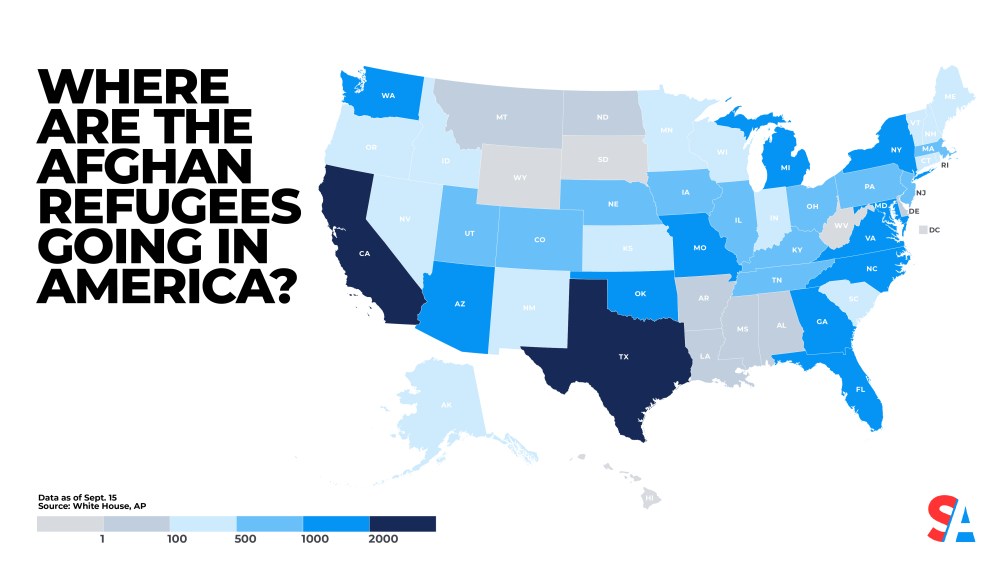This week, the Biden administration began to notify governors and state refugee coordinators across the country how many Afghan evacuees to expect. The first group consists of nearly 37,000 people.
All states except Hawaii, South Dakota, West Virginia, Wyoming, and the District of Columbia will welcome at least ten refugees. California is projected to take the most arrivals compared to any other state with more than 5,200 people according to State Department data for the Afghan Placement and Assistance program.
The projected number of refugees to be resettled per state is as follows:
- Alabama – 10
- Alaska – 100
- Arizona – 1,610
- Arkansas – 98
- California – 5,255
- Colorado – 865
- Connecticut – 310
- Delaware – 30
- Florida – 1,030
- Georgia – 1,069
- Hawaii – 0
- Idaho – 420
- Illinois – 860
- Indiana – 490
- Iowa – 695
- Kansas – 490
- Kentucky – 850
- Louisiana – 59
- Maine – 100
- Maryland – 1,348
- Massachusetts – 900
- Michigan – 1,280
- Minnesota – 275
- Mississippi – 10
- Missouri – 1,200
- Montana – 75
- Nebraska – 775
- Nevada – 150
- New Hampshire – 100
- New Jersey – 535
- New Mexico – 299
- New York – 1,143
- North Carolina – 1,169
- North Dakota – 49
- Ohio – 855
- Oklahoma – 1,800
- Oregon – 180
- Pennsylvania – 995
- Rhode Island – 150
- South Carolina – 175
- South Dakota – 0
- Tennessee – 415
- Texas – 4,418
- Utah – 765
- Vermont – 100
- Virginia – 1,166
- Washington – 1,679
- West Virginia – 0
- Wisconsin – 399
- Wyoming – 0
The Biden administration has requested funding from Congress to help resettle 65,000 Afghans in the United States by the end of this month and 95,000 by September 2022.
Former governor of President Joe Biden’s home state Delaware, Jack Markell, will temporarily serve as the point person on resettling Afghan evacuees in the United States.
According to the data, the states with a historically large number of Afghans who resettled in the U.S. over the last 20 years — such as California, Maryland, Texas, and Virginia — are again welcoming many evacuees.
Oklahoma is slated to resettle 1,800 new arrivals although the state has resettled a relatively small number of refugees throughout the 20-year war, .
Officials said the resettlements of Afghan evacuees are based on a few different factors, including where they might have family already located, which areas have plenty of job openings and cheaper housing, as well as taking into account the advice given to the State Department from local affiliates of nine national resettlement agencies that have partnered with the U.S. government.
Each Afghan evacuees goes through a process coordinated by the Department of Homeland Security, including security clearance and health screening before being admitted into the United States. Those 12 and older are also required to get a COVID-19 vaccine as part of their agreement for humanitarian parolee status once entering the country.
However, unexpected complications have slowed down the process. Cases of measles were discovered among several Afghans who had recently arrived in the U.S., and this has caused U.S.-bound flights for evacuees to be temporarily grounded in third-country processing sites.
Concerns for recent Afghan arrivals grow as the road ahead of them will be tough if Congress doesn’t take action to help them. Currently, evacuees are not eligible for food stamps, cash assistance through the Temporary Assistance for Needy Families program for low-income families, Medicaid, or other traditional services funded through the Department of Health and Human Services.
Currently, each refugee is expected to receive $1,225 to help with rent, furniture, and food and provide a small amount of pocket money. But Biden has called on Congress to ensure the recent Afghan evacuees receive the same benefits as other refugees.
